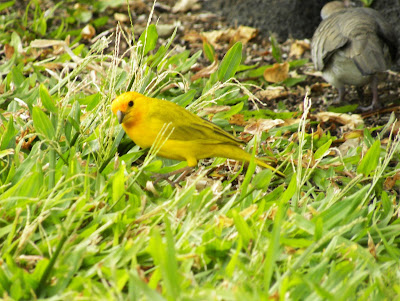Here are some more bird photos from my visit to the Reifel Bird Sanctuary:
This week the subject is Sandhill Cranes.
Sandhill Cranes are eager for handouts, all the ones I saw were very close to the entrance waiting to sample the wild bird feed that visitors buy as they enter the sanctuary.
I think the head and beak look prehistoric.
That beak looks sharp too, I was surprised both that they were accepting seed from peoples open palms and that people were feeding them that way. I didn't have any seed but would have scattered it on the ground if I had had any.
They also have a rather odd "bustle" type tail. They look to me a bit like a bird designed by a committee, each member concentrating on just a single feature; neck of a goose, body of a turkey, legs of a heron--I am sure you get the idea.
I will share some facts from:
"Sandhill Cranes are very large, tall birds with a long neck, long legs, and very broad wings. The bulky body tapers into a slender neck; the short tail is covered by drooping feathers that form a “bustle.” The head is small and the bill is straight and longer than the head."
"These are slate gray birds, often with a rusty wash on the upperparts. Adults have a pale cheek and red skin on the crown. Their legs are black. Juveniles are gray and rusty brown, without the pale cheek or red crown."
"Sandhill Cranes breed and forage in open prairies, grasslands, and wetlands. Outside of the breeding season, they often roost in deeper water of ponds or lakes, where they are safe from predators."
These ones have found a safe environment at the sanctuary, a sort of birdie bed and breakfast.
"Sandhill Cranes forage for grains and invertebrates in prairies, grasslands, and marshes. They do not hunt in open water or hunch their necks the way herons do. Sandhill Cranes form extremely large flocks—into the tens of thousands—on their wintering grounds and during migration. They often migrate very high in the sky."
"The Sandhill Crane’s call is a loud, rolling, trumpeting sound whose unique tone is a product of anatomy: Sandhill Cranes have long tracheas (windpipes) that coil into the sternum and help the sound develop a lower pitch and harmonics that add richness."
"Sandhill Cranes are known for their dancing skills. Courting cranes stretch their wings, pump their heads, bow, and leap into the air in a graceful and energetic dance."
"The earliest Sandhill Crane fossil, estimated to be 2.5 million years old, was unearthed in the Macasphalt Shell Pit in Florida."
"Sandhill Crane chicks can leave the nest within 8 hours of hatching, and are even capable of swimming."
"The omnivorous Sandhill Crane feeds on land or in shallow marshes where plants grow out of the water, gleaning from the surface and probing with its bill. Its diet is heavy in seeds and cultivated grains, but may also include berries, tubers, small vertebrates, and invertebrates. Nonmigratory populations eat adult and larval insects, snails, reptiles, amphibians, nestling birds, small mammals, seeds, and berries."
"Sandhill Cranes build their nests from the dominant vegetation—such as cattails, sedges, burr reeds, bulrushes, or grasses—using dried plant materials early in the season and adding green materials later on. To a foundation of larger materials they add a cup-shaped hollow lined with smaller stems or twigs. Both mates may gather material, tossing it over their shoulders to form a mound. The female is usually the one to stand on the mound and arrange the material."
"The oldest Sandhill Crane on record was at least 36 years, 7 months old. Originally banded in Wyoming in 1973, it was found in New Mexico in 2010."
"The North American Waterbird Conservation Plan lists them as a Species of Low Concern, and estimates the species as an 11 out of 20 on the Continental Concern Score."
"The future of Sandhill Cranes is mainly tied to the fate of their habitat. It’s particularly important to conserve wetlands in the ranges of nonmigratory populations, and in staging and wintering areas where large migratory flocks congregate."
...and a short video:
and another video/audio of the Sandhill Crane's call:
Well that is all for this week, I hope you have enjoyed getting up close to a Sandhill Crane.
Happy Wednesday, with whimsy,
Gillian.











































